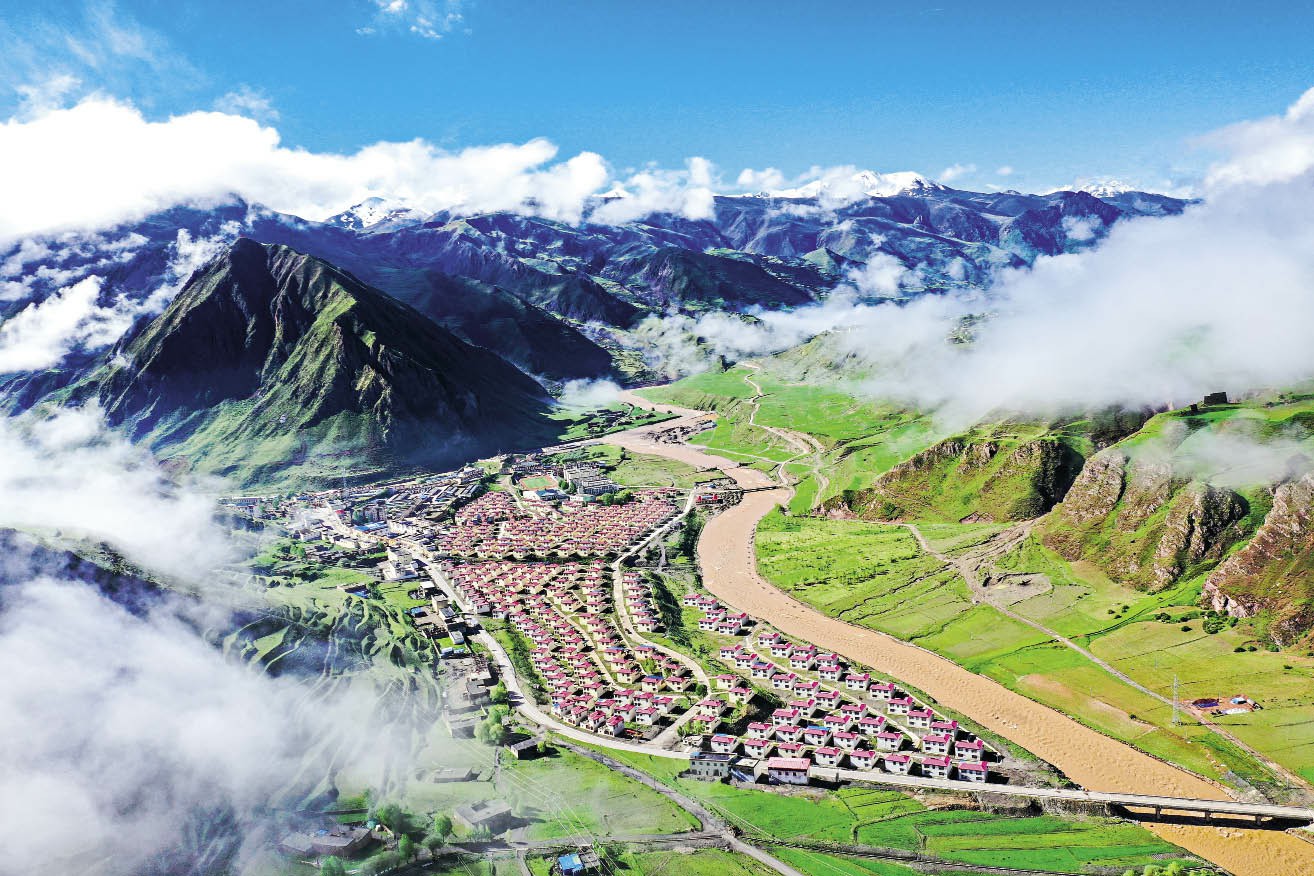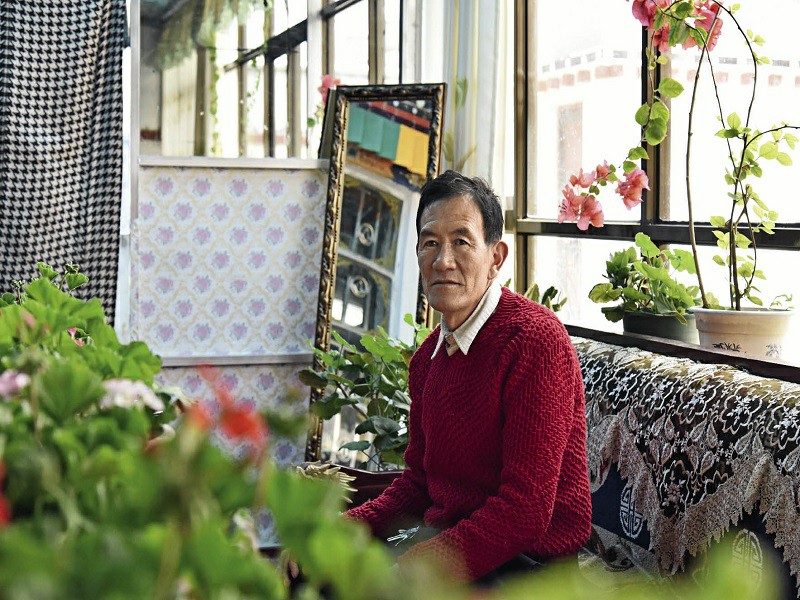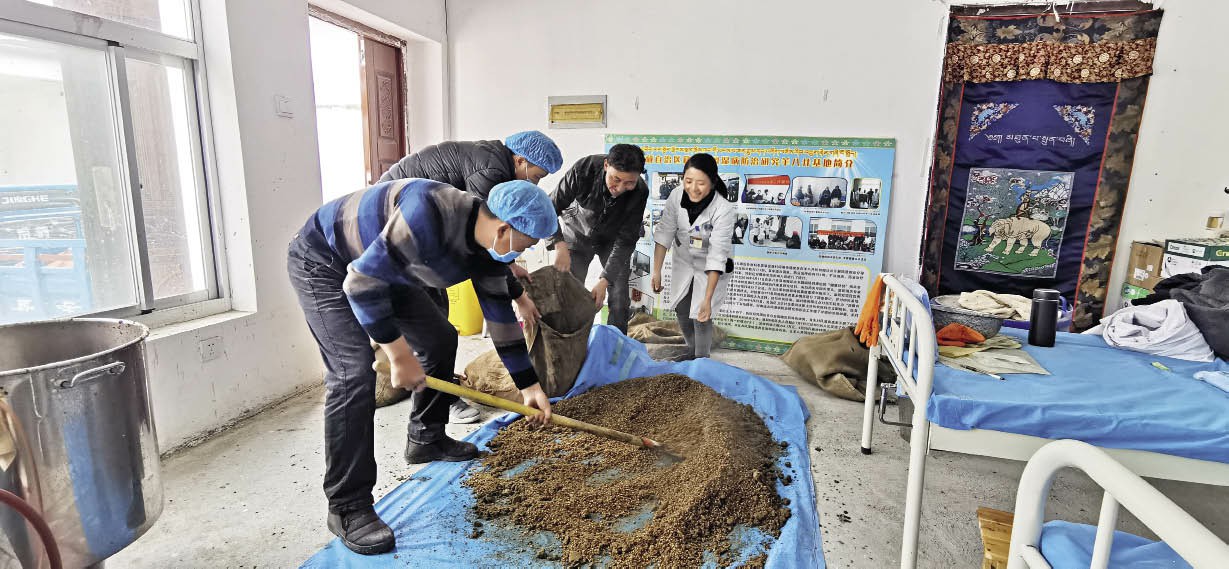 An aerial view of the relocation site for poverty alleviation in Dengqen County in Tibet.
An aerial view of the relocation site for poverty alleviation in Dengqen County in Tibet.
FIFTY-five-year-old Sonam Yeshe has a wealth of “moving” experience. He grew up in Menshi, a typical pastoral village in Gar County, Tibet Autonomous Region. As a pastoralist his work each year involved grazing yaks and sheep and herding them in three seasonal migrations to summer, autumn, and winter pastures. At the end of 2017 he and his family moved to the Kangle Xinju poverty-relief relocation site in Gar County. They now no longer have to move three times a year.
Poverty relief through relocation is an important way to help the poor in China find a better life. The measure has been adapted to the Tibetan Plateau in that it relocates residents of areas four or more kilometers above sea level with poor living environments that lack the basic conditions for human development to lower-altitude areas whose public services ensure better life and health. And by reducing human activities in high-altitude areas, relocation also allows wild animals to return to their natural habitats. It thus protects the plateau’s ecological environment.
For the Good of the Common Home
Sitting comfortably in his sunny living room, Sonam relates how he came to live in that town. “Before relocation took place, village and township officials asked us how we felt about it. I was the first to raise my hand in agreement because I wanted to live in town.”
After nearly six months of preparation, Sonam sold his family’s 30 yaks and 60 sheep, and by 2018 had moved into his new home — a two-story 150-square-meter Tibetan-style building. Downstairs has a kitchen, living room, and wash room, and five bedrooms along the upstairs corridor.
“Breathing and life generally is easier at a lower altitude.” Sonam’s new home has running water and is connected to the power grid. In his old home the toilet was outside, melted ice was the source of drinking water, and he used dung for cooking and heating. Solar power was insufficient even to charge a mobile phone.
Ci Qiangmu, who lives in the Senburi ecological relocation resettlement site in Konggar County, Shannan City, feels the same way. She moved to Senburi from Tsonyi County, Nagqu City, at the end of 2019. Her parents and seven children, all married, have been assigned two-story terraced courtyard houses on the resettlement site. “It’s easier here for seniors to see a doctor and for children to go to school. But what’s most important is that our old neighbors are close by. So, despite our new living environment, we don’t feel alienated or lonely,” Ci Qiangmu said.
Sonam and Ci Qiangmu have different reasons for wanting this move.
To look for grass for their livestock, in the 1970s a group of herders drove cattle and sheep in a 300-kilometer migration from Xainza County, Nagqu City, to an uninhabited area where the average attitude was 5,000 meters. This move gave birth to Tsonyi County, the highest county in China.
From the standpoint of a “testing ground for human physiological limits,” the damage that high altitude inflicts on people’s health is obvious. The harsh natural environment at such high elevation causes such illnesses as rheumatism and heart disease. This large area with a sparse population, scant resources, and low accessibility to infrastructure and public services demands all-encompassing ecological protection tasks, and is deeply steeped in poverty. All this makes developing the area particularly difficult.
However, Tsonyi, known as the “Ghost Land,” is a haven for wild animals. The county, located in the Qiangtang National Nature Reserve, is on the migratory routes of Tibetan antelopes, wild donkeys, and yaks.
“As the human population grows, so do their material needs. Therefore, the conflict between domestic and wild animals competing for pasture resources has become ever more prominent, and made ecological protection in nature reserves considerably more difficult,” said Zahi Dorji, head of the Nature Reserve Management Office of the Tibet Forestry and Grassland Bureau. Other areas of ultra-high altitude in addition to Tsonyi include nine nature reserves. And grassland degradation is increasing at an annual rate of three to five percent.
To make more room for wildlife, at the end of 2019, 2,900 residents of the county trekked almost 1,000 kilometers southward and relocated to the north bank of the Yarlung Zangbo River, whose altitude is 3,600 meters. There they embarked on a new life in an environment far better suited to human habitation.
To take care of the cattle and sheep left behind by this move, the local government specified a transitional period of a few years and set up cooperatives in the villages that people had left. Those who had moved out took shares in pastures, cattle, and sheep, while a number of young and middle-aged people stayed behind to graze the livestock. This temporarily resolved the matter of livestock and sources of livelihood. At the end of the transition period, young and middle-aged people who had stayed behind will go to their new homes in Semburi to reunite with their families. Their former homes will then revert to the mountainous haven for wildlife it once was.
The Ecological Relocation Plan for Extremely High Altitude Areas (2018-2025), compiled by Tibet Autonomous Region, involves 450 villages in Nagqu, Ngari, and Xigaze, all with an altitude of above 4,800 meters, and 130,000 people, among whom around 100,000 will be resettled along the Yarlung Zangbo River, forming a modern town with complete functions. Upon completion of the project, Tibet will vacate nearly 350,000 square kilometers of land, including 280,000 square kilometers of protected areas. This will promote comprehensive improvement of these areas’ ecological environment. Meadow steppe coverage will increase by around 10-20 percent, and desert steppe coverage by an average 5-10 percent.

Sitting in his sun-lit room, Sonam Yeshe narrates his story of moving to the town.
Life’s Dignity Restored
To ensure people’s stable living after their move, good follow-up work of making living arrangements for relocated people is essential.
New Tibetan-style houses are arranged in an orderly fashion in Caiqutang Village, Lhasa City. The village has an activity center and a full range of supporting facilities, and hospitals, schools, and markets are nearby. In addition to these amenities, Caiquitang also features the distinct scenic delight of hot springs.
The village is 4,300 meters above sea level and has abundant geothermal resources, according to village chief Dekyi Paldron. It has, therefore, become a resettlement site for rheumatism sufferers under the targeted poverty alleviation program. During the winter of 2017, hundreds of herders from alpine mountainous areas of Nagqu, Ngari, and Changdu suffering from severe rheumatic diseases moved here. They gradually recovered through a treatment that combines Tibetan medicine and hot spring bathing.
Tenzin Dargye is from Nyima County, with an average altitude of 5,000 or more meters. Owing to the local altitude, climate, and undeveloped healthcare, he, like other people who had lived there for generations, suffered from rheumatism. As the mainstay of his family, Tenzin Dargye’s illness had exacerbated their poverty.
In 2017, Tenzin, along with 600 or more other villagers, relocated to Caiqutang Village. “Here I can soak in the hot springs every day, and my health condition has improved a lot.”
“Among these 625 people, 361 had no ability to work, and 171 were suffering from rheumatoid or rheumatic arthritis. Many families were impoverished due to illness,” said Tseten Palkyi, leader of the Tibet People’s Hospital work team in Caiqutang Village.
To deal with this situation, the work team used resources of the Tibet People’s Hospital and the Tibetan Medical and Astrological Institute. It also organized follow-up treatment and instituted rehabilitation files for rheumatism sufferers.
Nowadays, Tenzin Dargye, having suffered illness and pain, often soaks in hot springs with his fellow villagers as a rehabilitation exercise. Since recovering, his quality of life has considerably improved. Relocation has in effect restored dignity to his life.

Utilizing local geothermal resources, doctors treat Caiqutang residents suffering from rheumatism using a combination of Tibetan medicine and hot spring water.
Road to Prosperity
To increase the employment prospects for relocated residents, Caiqutang Village has organized training for all kinds of jobs, such as driving and culinary, to ensure that everyone has at least one job skill.
The poverty relief through relocation program resulted in the resettlement of Zhaqu’s family in a two-story 120-square-meter courtyard home. They opened a teahouse on the first floor that earns at least RMB 200 a day. “My daughter and I run the teahouse because it allows us to work while taking care of the children. It brings in more income than the whole family earned from doing gig jobs and herding animals. The government has also organized job skills training that members of my family can take part in,” Zhaqu said. The village committee encourages villagers to start their own businesses, and 15 shops, four teahouses, and four billiard rooms have been established. All are thriving.
Facilities such as a fresh grass storage cellar, hay sheds, and a water pump house are all available in the village’s sheep fattening cooperative, whose 2,250 sheep (15 per household) increases the income of relocated households by more than RMB 3,700. The village committee, while busily applying for more industrial projects, is vigorously developing the village’s collective economy, according to Deji Paldron. Before too long, residents will be able to find employment in the village.